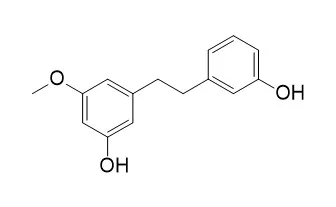| In vitro: |
| J Chem Ecol. 2004 Jan;30(1):215-27. | | Potential toxic effect on aquatic fauna by the dwarf shrub Empetrum hermaphroditum.[Pubmed: 15074667] | The common evergreen dwarf shrub Empetrum hermaphroditum has influence on the functioning of boreal terrestrial ecosystems in northern Sweden. The negative effects of E. hermaphroditum are partly attributed to the production of the dihydrostilbene, Batatasin III, which is released from leaves and litter by rain and snowmelt.
METHODS AND RESULTS:
In this study, we investigated whether Batatasin III is carried by runoff into streams and lakes during the snowmelt period and whether it is also potentially hazardous to aquatic fauna. The maximum concentration of Batatasin III found was 1.06 mg l(-1). The proportion of dead yolk sac alevins increased significantly (P < 0.001) with increasing concentrations of Batatasin III and time of exposure. After 24 hr, EC50 was 10 mg l(-1). It was 2 mg l(-1) after 48 hr. The effect of phenol was negligible, indicating a specific phytotoxic effect of the bibenzyl structure of Batatasin III. The proportion of mobile D. magna became significantly smaller (P < 0.001) with increasing concentrations of Batatasin III, with decreasing pH, and with increasing exposure time. EC50 varied between 7 and 17 mg l(-1) at pH 5.5 and 7.0, respectively. After 24 hr EC50 decreased and was 2.5 at pH 5.5 and 12 mg l(-1) at pH 7.0. The levels of Batatasin III found in the field samples were below the lowest EC50 in acute toxicity tests.
CONCLUSIONS:
However, in view of the interactive effect of pH and exposure time, this study suggests that this stable plant metabolite may impose a lethal effect on the aquatic fauna in small streams. | | Physiol Plant. 2001 Nov;113(3):368-376. | | The inhibition of ammonium uptake in excised birch (Betula pendula) roots by batatasin-III.[Pubmed: 12060282] | We investigated whether Batatasin III has the potential to interfere with NH4+ uptake in birch (Betula pendula) roots.
METHODS AND RESULTS:
Excised birch roots were exposed to Batatasin III during brief periods in 15NH4+ solutions, and then analyzed for labeled N.
Batatasin III inhibited N-NH4+ uptake by 28, 89 and 95% compared with the control, when roots were treated with 0.1, 1.0 and 2.8 mM of Batatasin III, respectively. The effect of 1.0-mM Batatasin III was greater at pH 4.2 than at pH 6.8. In addition, the inhibition of N-NH4+ uptake by Batatasin III was not reversed after rinsing the roots in water and transferring them to a Batatasin III free solution. Furthermore, birch seedlings immersed in a 1.0-mM Batatasin III solution for 2 h, and then replanted in pots with soil, had decreased growth, such that 10 weeks after treatment, the dry mass of both shoots and roots was reduced by 74 and 73%, respectively, compared with control seedlings. This suggests that a brief exposure to Batatasin III may have a long-term inhibitory effect on whole plant growth. Using plasma membrane vesicles isolated from easily extractable spinach (Spinacia oleracea) leaves, it was found that Batatasin III strongly inhibited proton pumping in isolated plasma membrane vesicles, while it only slightly inhibited ATP hydrolytic activity. The uncoupling of proton pumping from ATP hydrolytic activity suggests that Batatasin III disturbs membrane integrity.
CONCLUSIONS:
This hypothesis was further supported by a greater efflux of ions from birch roots immersed in a Batatasin III solution than from roots in a control solution. | | Anticancer Res . 2017 Nov;37(11):6281-6289. | | Batatasin III Inhibits Migration of Human Lung Cancer Cells by Suppressing Epithelial to Mesenchymal Transition and FAK-AKT Signals[Pubmed: 29061811] | | Abstract
Background/aim: Lung cancer is the leading cause of cancer-related deaths worldwide. Compound Batatasin III isolated from Dendrobium draconis Rchb.f. was tested for the possible anti-cancer activities including anti-proliferative, anti-migration and invasion in human non-small lung cancer H460 cells.
Materials and methods: The effect of Batatasin III on viability and proliferation of H460 cells was investigated by the 3-[4,5-dimethylthiazol-2-yl]-2,5diphenyl tetrazoliumbromide (MTT) assay. Migration and invasion assays were performed. Filopodia formation was determined by phalloidin-rhodamine staining. The hallmark signaling proteins in regulation of epithelial to mesenchymal transition (EMT), proliferation, and migration were determined by western blot analysis.
Results: Batatasin III at concentrations lower than 100 μM has no cytotoxic effects. The compound at 25-100 μM exhibited anti-proliferative activity at 48 h after treatment. Regarding cell motility, Batatasin III decreased migration and invasion of cells. Filopodia were found to be significantly reduced in Batatasin III treated cells. These effects correlated with the results from western blot analysis showing that the phosphorylation of focal adhesion kinase on Try397 (p-FAK (Try397)), the active protein kinase B (AKT), and cell division cycle 42 (CDC42) were significantly reduced. Besides, Batatasin III significantly suppressed EMT indicated by the decrease of N-cadherin and Vimentin, and up-regulation of E-cadherin.
Conclusion: Batatasin III has anti-cancer activities; inhibits cancer migration and invasion by suppressing EMT. Our findings establish Batatasin III as a potential compound for further studies aimed at finding a better, more effective treatment approach for lung cancer.
Keywords: AKT; Batatasin III; FAK; epithelial to mesenchymal transition; invasion; lung cancer; migration. |
|






 Cell. 2018 Jan 11;172(1-2):249-261.e12. doi: 10.1016/j.cell.2017.12.019.IF=36.216(2019)
Cell. 2018 Jan 11;172(1-2):249-261.e12. doi: 10.1016/j.cell.2017.12.019.IF=36.216(2019) Cell Metab. 2020 Mar 3;31(3):534-548.e5. doi: 10.1016/j.cmet.2020.01.002.IF=22.415(2019)
Cell Metab. 2020 Mar 3;31(3):534-548.e5. doi: 10.1016/j.cmet.2020.01.002.IF=22.415(2019) Mol Cell. 2017 Nov 16;68(4):673-685.e6. doi: 10.1016/j.molcel.2017.10.022.IF=14.548(2019)
Mol Cell. 2017 Nov 16;68(4):673-685.e6. doi: 10.1016/j.molcel.2017.10.022.IF=14.548(2019)